Five IBEW members have been honored for acting heroically to save lives last fall during one of the deadliest mass shootings in United States history.
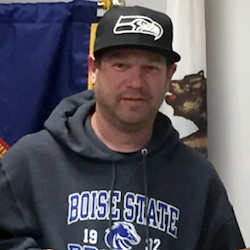 Collyn Berling
Collyn Berling
|
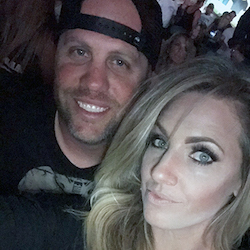 Mike Hesselton (with his wife, Cindy)
Mike Hesselton (with his wife, Cindy)
|
“As we approach the first anniversary of last year’s tragic Las Vegas massacre, the IBEW is proud to honor these members, each of whom bravely put others’ safety before their own,” said International President Lonnie R. Stephenson.
On Stephenson’s behalf, Seventh District International Executive Council member and Business Manager of Diamond Bar, Calif., Local 47 Pat Lavin presented the union’s Life Saving Award to Local 47 members Collyn Berling, Justin Burton, Mike Hesselton, and Michael Robertson. Also honored was Jake Codemo, a traveling journeyman lineman member of St. Louis Local 2 who works under the jurisdiction of Local 47.
Fifty-eight people were killed and more than 800 were injured in the shooting that took place Oct. 1, 2017, near the end of the Route 91 Harvest country music festival, a three-day event held at the Las Vegas Village open-air venue near the southern end of the city’s world-famous casino “Strip.” Each of the honored IBEW members had attended the festival independent of the others.
Shortly after 10 p.m. that Sunday, a shooter barricaded himself in his 32nd-floor room in the Mandalay Bay Resort and Casino, then used several modified assault rifles to rapidly fire across Las Vegas Boulevard and into the crowd of nearly 22,000 concert-goers. Although he seemed to have planned the attack in detail, police have not been able to determine a motive for the shooting. Officers who forced their way into his hotel room found him dead of an apparently self-inflicted gunshot.
When the shots began during singer Jason Aldean’s festival-closing set, Hesselton was standing to the right of the stage with his wife, Cindy, and his teenage son, Noah. Burton said that he and his friends were about 100 feet from the stage when the first rounds came. Robertson, his wife, Paula, and their friends had made it a little closer to the stage; and Codemo and his group also were situated toward the front of the crowd.
At first, “we heard a lot of popping sounds,” Robertson said. When more gunfire soon followed, “I realized this is someone shooting,” he said, and he instinctively used his body to shield Paula.
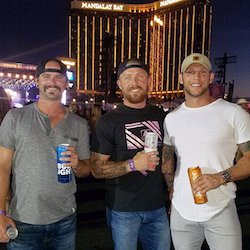 Jake Codemo (center)
Jake Codemo (center)
|
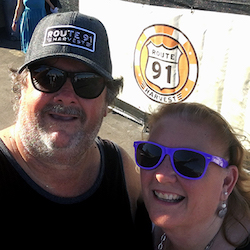 Michael Robertson (with his wife, Paula)
Michael Robertson (with his wife, Paula)
|
The shots were fired from far enough away that they didn’t sound that threatening to Burton. But once he and other concert-goers figured out what was happening, everybody dropped to the ground, he said.
Hesselton, an Air Force veteran, pulled Cindy and Noah down and used his body to protect them from the gunfire. “As soon as I hit the ground, I got hit,” he said. A bullet grazed his back.
As Codemo and his friends ran for cover in the ensuing chaos, he spotted a seriously injured woman lying on the ground, helpless. As he carried her to a rapidly overflowing first aid tent, he thought about his own wife. “I’d want someone to do that for her if she was alone,” he said. Codemo applied pressure to her wounds while they waited for medical attention.
Meanwhile, as Burton directed his wife, Jade, and a couple of their friends toward a gate near the venue’s south end, two bullets struck him in his lower back. Both narrowly missed his spinal cord, although he learned later that one cracked his pelvic bone. “I got really lucky,” said Burton, who safely shepherded his group through an open gate.
Berling also was shot as he protected his girlfriend, Jill, from the gunfire. One bullet shattered when it reached bone, sending metal fragments throughout his hip and leg. Another grazed his ankle.
“As the rounds were going off, it felt like something hit me in the butt,” said Robertson, who estimated that the barrage lasted about 10 minutes. The gunshot “didn’t hurt a lot,” he said, so he was able to usher his wife and friends to a nearby exit. From there, Robertson was driven to a hospital in a sedan that had been pressed into emergency ambulance service. Hesselton had a similar experience, catching a lift to the hospital via some “good Samaritans” who eased him into their car.
Burton was placed into a crowded ambulance. When another arrived near the tent where Codemo and the critically injured woman had found refuge, he convinced the driver to take them both to a hospital. Because there was almost no room inside, Codemo had to stand in the back of the ambulance and hold her.
“Wounded people occupied just about every available space” at the hospital, Robertson said. There, he learned that a bullet fragment had sliced across his lower digestive tract. He spent almost three weeks in the hospital and underwent four surgeries, including an ileostomy that temporarily rerouted part of his small intestine to an external bag. The bullet wound healed, but complications kept doctors from reversing the ileostomy for several months. Robertson has not yet returned to work; his last surgery is scheduled for next month.
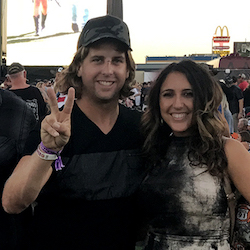
Justin Burton (with his wife, Jade)
|
Doctors had to wait for some swelling to subside before removing shrapnel from Berling’s body. His painful injuries and subsequent rehabilitation kept the helicopter lineman off the job for several months.
Burton’s doctors, meanwhile, judged it safer to leave the two bullets embedded on either side of his spine rather than risk permanent injury trying to remove them. After two days in the hospital, Burton was released, and he was back to work about a month later. “I have a little bit of a numb feeling, still,” he said.
Closing Hesselton’s graze wound required 20 surgical staples — with “no anesthesia,” he said. After a brief overnight hospital stay, Hesselton and his family returned home; he was on the job a week later.
Codemo took only a couple of days off after the massacre. “Work keeps me busy,” he said. “I’m not going to let it faze me.” The woman he rescued was released after about two weeks in the hospital, he said, and they have stayed in touch since.
Each of these Life Saving Award honorees said they have access to contract-provided employee assistance program benefits should they need counseling or other help.
Lots of IBEW members, of course, work in potentially dangerous situations and areas that can be out of easy reach of quick medical treatment. That’s why a good number of brothers and sisters prepare themselves to handle emergencies by taking first-aid, CPR and other safety training courses.
“Some of that training and quick thinking clearly kicked in for these honorees,” Stephenson said. “Without their heroic efforts, this already awful tragedy could have been even worse.”
Visit ibew.org/safety-health to learn more about IBEW’s Life-Saving Awards.